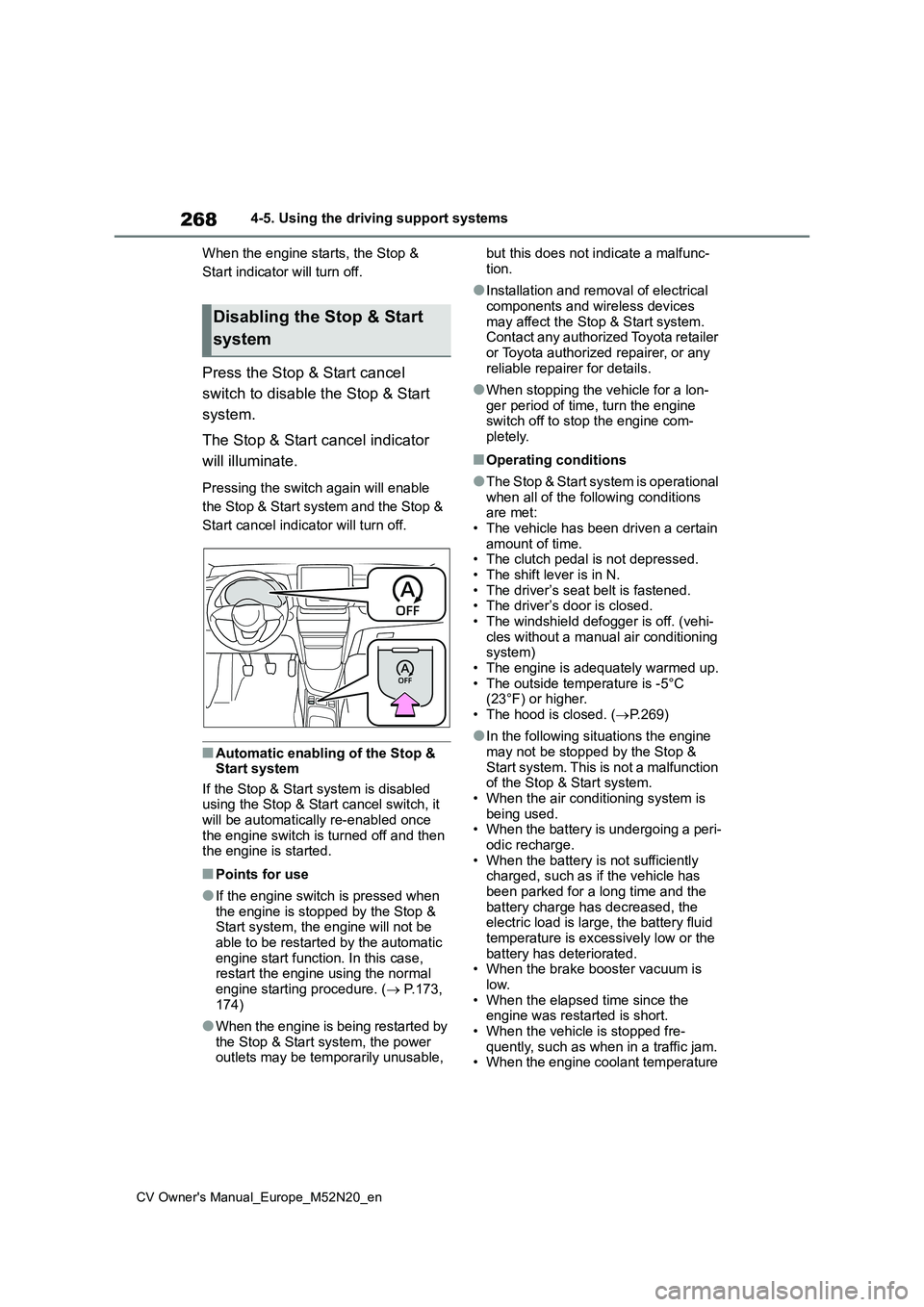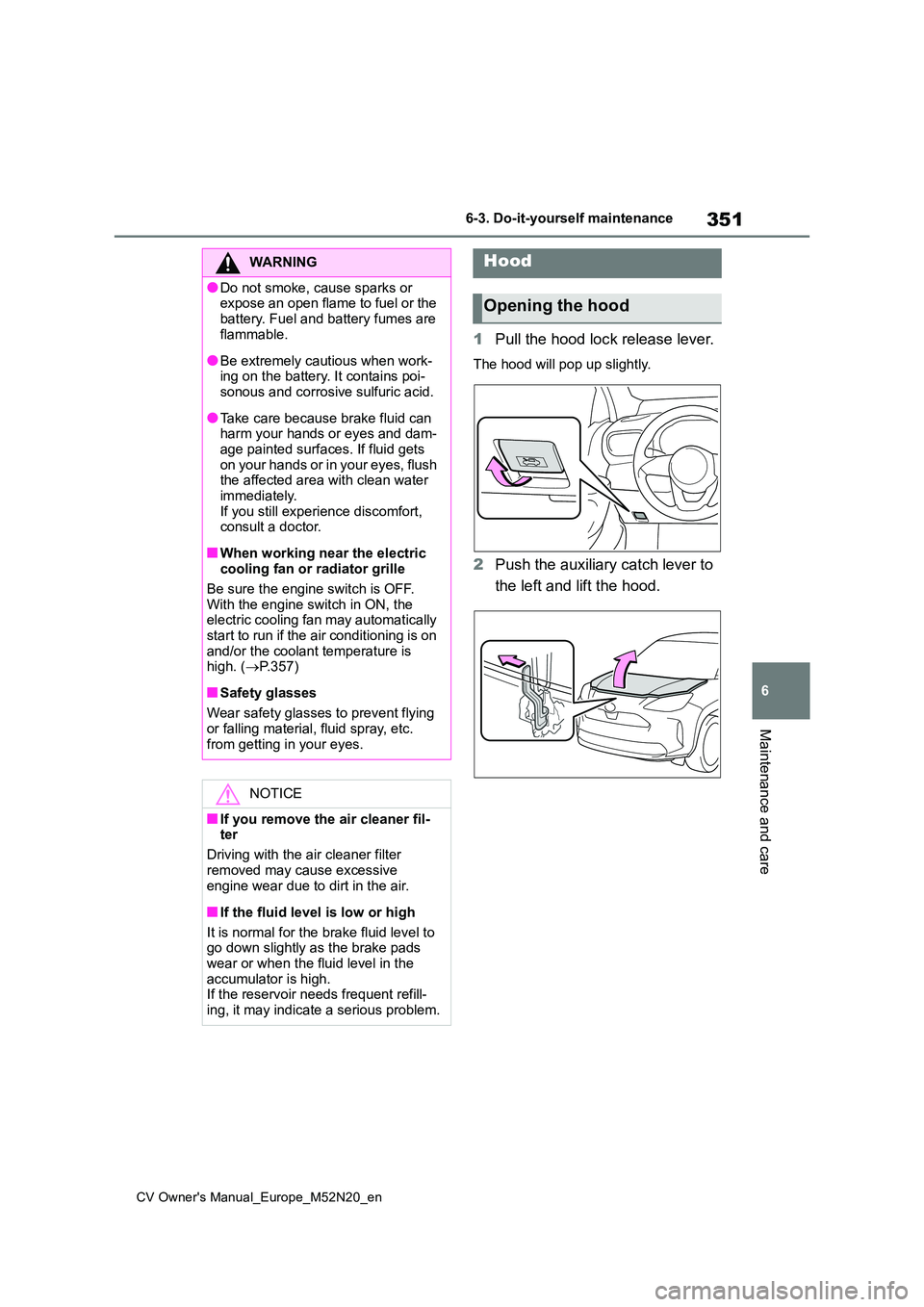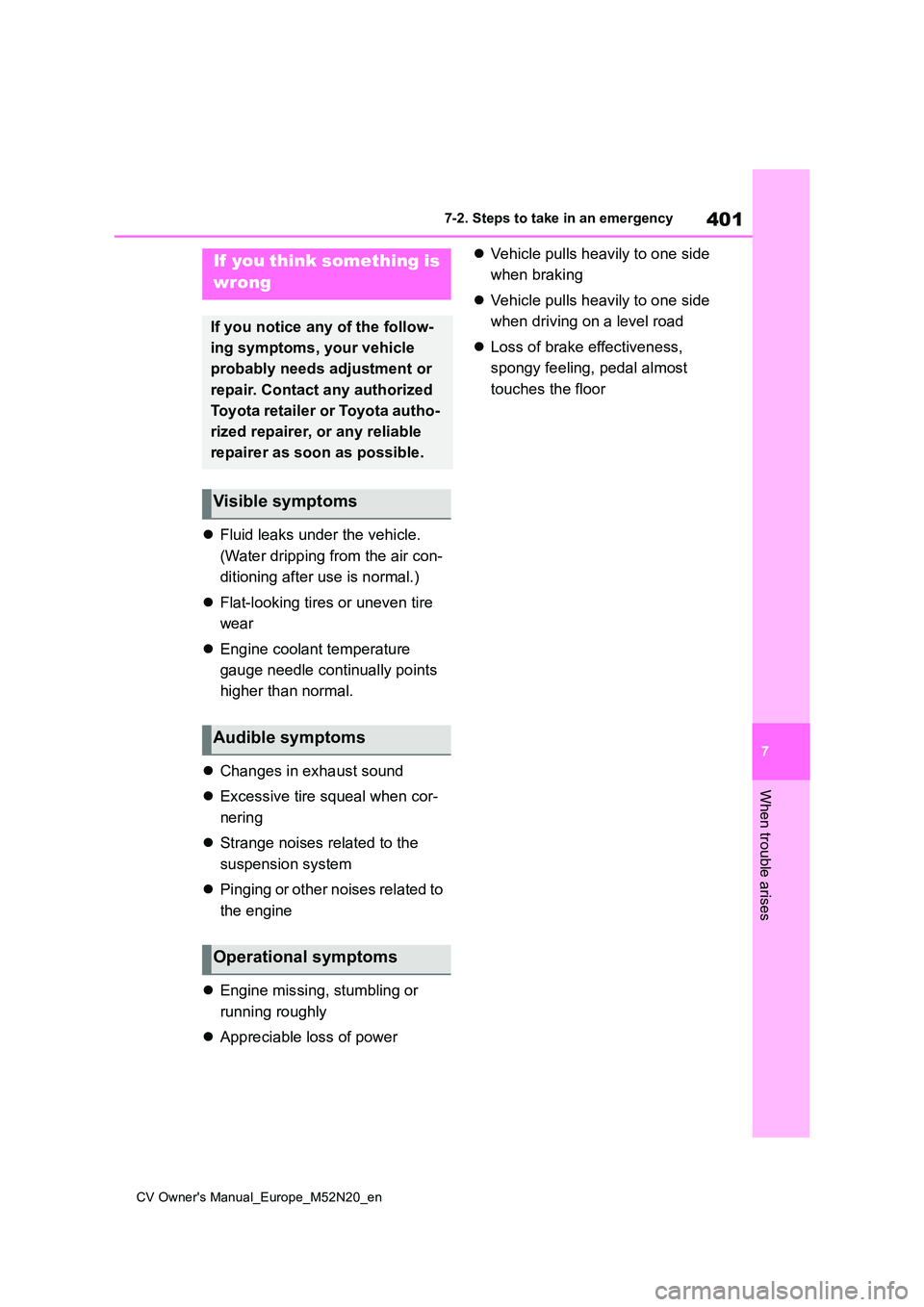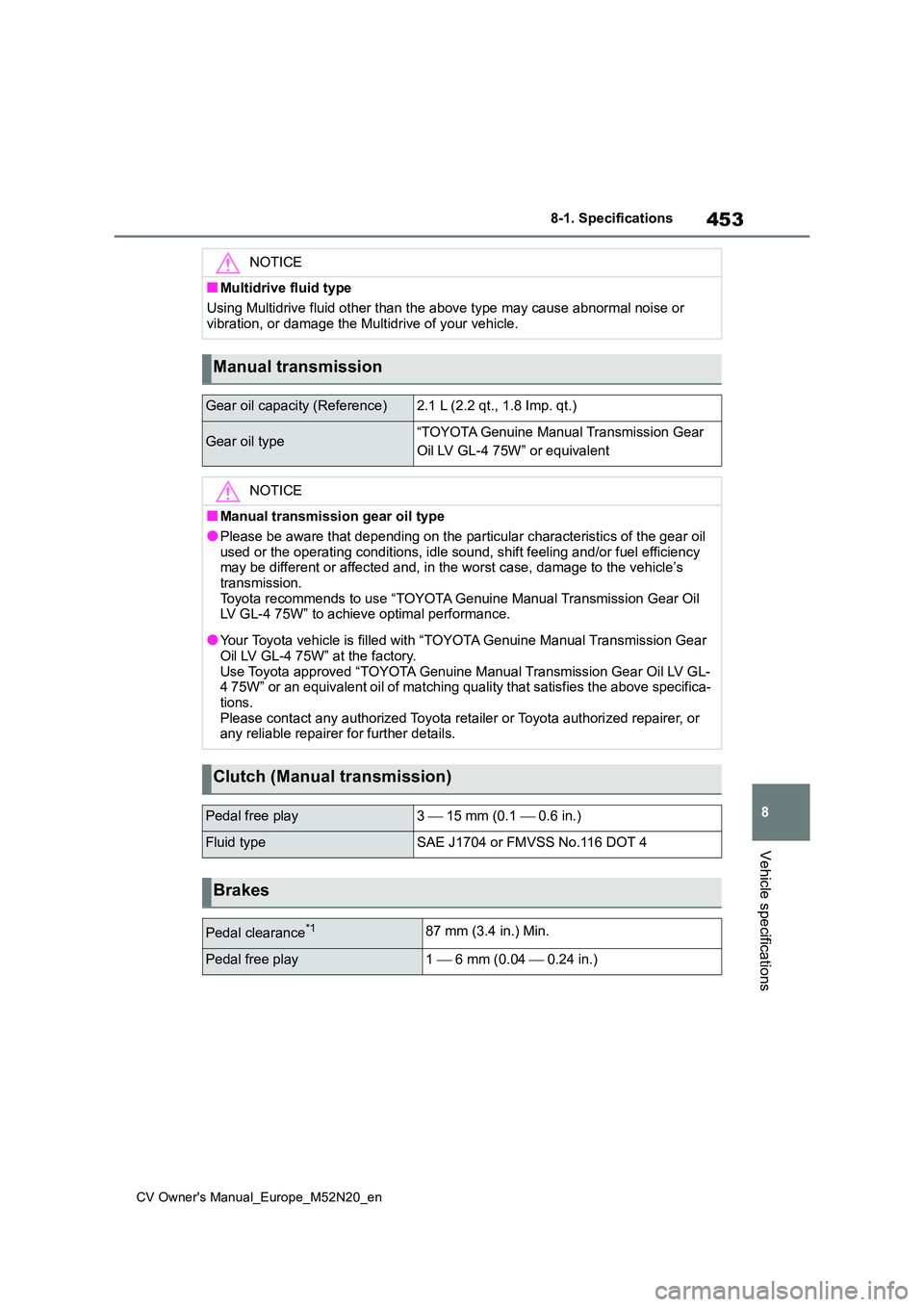2022 TOYOTA YARIS CROSS brake fluid
[x] Cancel search: brake fluidPage 270 of 618

268
CV Owner's Manual_Europe_M52N20_en
4-5. Using the driving support systems
When the engine starts, the Stop &
Start indicator will turn off.
Press the Stop & Start cancel
switch to disable the Stop & Start
system.
The Stop & Start cancel indicator
will illuminate.
Pressing the switch again will enable
the Stop & Start system and the Stop &
Start cancel indicator will turn off.
■Automatic enabling of the Stop & Start system
If the Stop & Start system is disabled using the Stop & Start cancel switch, it will be automatically re-enabled once
the engine switch is turned off and then the engine is started.
■Points for use
●If the engine switch is pressed when the engine is stopped by the Stop & Start system, the engine will not be
able to be restarted by the automatic engine start function. In this case, restart the engine using the normal
engine starting procedure. ( P.173, 174)
●When the engine is being restarted by the Stop & Start system, the power outlets may be temporarily unusable,
but this does not indicate a malfunc-
tion.
●Installation and removal of electrical
components and wireless devices may affect the Stop & Start system. Contact any authorized Toyota retailer
or Toyota authorized repairer, or any reliable repairer for details.
●When stopping the vehicle for a lon-ger period of time, turn the engine switch off to stop the engine com-
pletely.
■Operating conditions
●The Stop & Start system is operational
when all of the following conditions are met:• The vehicle has been driven a certain
amount of time. • The clutch pedal is not depressed.• The shift lever is in N.
• The driver’s seat belt is fastened. • The driver’s door is closed.• The windshield defogger is off. (vehi-
cles without a manual air conditioning system)• The engine is adequately warmed up.
• The outside temperature is -5°C (23°F) or higher.• The hood is closed. ( P.269)
●In the following situations the engine may not be stopped by the Stop &
Start system. This is not a malfunction of the Stop & Start system.• When the air conditioning system is
being used. • When the battery is undergoing a peri-odic recharge.
• When the battery is not sufficiently charged, such as if the vehicle has been parked for a long time and the
battery charge has decreased, the electric load is large, the battery fluid temperature is excessively low or the
battery has deteriorated. • When the brake booster vacuum is low.
• When the elapsed time since the engine was restarted is short.• When the vehicle is stopped fre-
quently, such as when in a traffic jam. • When the engine coolant temperature
Disabling the Stop & Start
system
Page 271 of 618

269
4
CV Owner's Manual_Europe_M52N20_en
4-5. Using the driving support systems
Driving
or transmission fluid temperature is
extremely low or high. • When the steering wheel is being operated.
• When the vehicle is being driven in a high altitude area.• When the battery fluid temperature is
extremely low or high. • For a while after the battery terminals have been disconnected and recon-
nected.
●When the engine is stopped by the
S t o p & S t a r t s y s t e m , t h e e n g i n e w i l l b e restarted automatically if any of the following conditions are met:
(To enable the engine to be stopped by
the Stop & Start system again, drive the
vehicle.)
• The air conditioning system is turned on. (vehicles without a manual air conditioning system)
• The windshield defogger is turned on. (vehicles without a manual air condi-tioning system)
• The driver’s seat belt is unfastened. • The driver’s door is opened.• The Stop & Start cancel switch is
pressed. • The steering wheel is operated.• The vehicle starts to roll on an incline.
●When the engine is stopped by the Stop & Start system, the engine may
restart automatically in the following situations: (To enable the engine to be stopped by the Stop & Start system
again, drive the vehicle.) • When the brake pedal is pumped or strongly depressed.
• When the air conditioning system is being used.• When a switch of the air conditioning
system is operated (windshield defog- ger switch, etc.).• If the battery charge becomes low.
■When the hood is opened
●If the hood is opened while the engine is stopped by the Stop & Start system,
the engine will stall and will not be able to be restarted by the automatic engine start function. In this case,
restart the engine using the normal
engine starting procedure. ( P.173, 174)
●If the hood is closed after the engine is started with the hood open, the Stop & Start system will not operate. Close
the hood, turn the engine switch off, wait 30 seconds or more, and then start the engine.
■Air conditioning system operation
while the engine is stopped by the Stop & Start system
Vehicles with an automatic air condition-
ing system: When the air conditioning is in automatic mode and the engine is stopped by the Stop & Start system, the
fan may operate at a low speed in order to prevent the temperature in the cabin from increasing or decreasing or may be
stopped.
To prioritize air conditioning system per- formance when the vehicle is stopped,
disable the Stop & Start system by pressing the Stop & Start cancel switch.
●If the windshield is fogged up
Turn the windshield defogger on.
( P.313, 318)
If the windshield fogs up frequently,
press the Stop & Start cancel switch to
disable the Stop & Start system.
●If an odor is emitted from the air con-
ditioning system • Vehicles with a manual air condition-ing system
If the idling stop time setting is set to
“Extended”, change it to “Standard”. If
an odor is emitted when the idling stop
time setting is set to “Standard”, press
the Stop & Start cancel switch to deacti-
vate the Stop & Start system.
• Vehicles with an automatic air condi- tioning system
Press the Stop & Start cancel switch to
deactivate the Stop & Start system.
Page 351 of 618

349
6
CV Owner's Manual_Europe_M52N20_en
6-2. Maintenance
Maintenance and care
request that a record of maintenance
be kept.
■Does your vehicle need repairs?
Be on the alert for changes in perfor- mance and sounds, and visual tip-offs
that indicate service is needed. Some important clues are:
●Engine misses (misfire), stumbling or pinging
●Appreciable loss of power
●Strange engine noises
●A fluid leak under the vehicle (How-ever, water dripping from the air con-
ditioning system after use is normal.)
●Change in exhaust sound (This may
indicate a dangerous carbon monox- ide leak. Drive with the windows open and have the exhaust system checked
immediately.)
●Flat-looking tires, excessive tire
squeal when cornering, uneven tire wear
●Vehicle pulls to one side when driven straight on a level road
●Strange noises related to suspension movement
●Loss of brake effectiveness, spongy feeling brake pedal or clutch pedal (vehicles with a manual transmission),
pedal almost touches the floor, vehicle pulls to one side when braking
●Engine coolant temperature continu-ally higher than normal ( P.85, 89)
If you notice any of these clues, take
your vehicle to any authorized Toyota
retailer or Toyota authorized repairer, or
any reliable repairer as soon as possi-
ble. Your vehicle may need adjustment
or repair.
Page 353 of 618

351
6
CV Owner's Manual_Europe_M52N20_en
6-3. Do-it-yourself maintenance
Maintenance and care
1Pull the hood lock release lever.
The hood will pop up slightly.
2Push the auxiliary catch lever to
the left and lift the hood.
WARNING
●Do not smoke, cause sparks or expose an open flame to fuel or the
battery. Fuel and battery fumes are flammable.
●Be extremely cautious when work-ing on the battery. It contains poi-sonous and corrosive sulfuric acid.
●Take care because brake fluid can harm your hands or eyes and dam-
age painted surfaces. If fluid gets on your hands or in your eyes, flush the affected area with clean water
immediately. If you still experience discomfort, consult a doctor.
■When working near the electric cooling fan or radiator grille
Be sure the engine switch is OFF. With the engine switch in ON, the electric cooling fan may automatically
start to run if the air conditioning is on and/or the coolant temperature is high. ( P.357)
■Safety glasses
Wear safety glasses to prevent flying
or falling material, fluid spray, etc. from getting in your eyes.
NOTICE
■If you remove the air cleaner fil-ter
Driving with the air cleaner filter
removed may cause excessive engine wear due to dirt in the air.
■If the fluid level is low or high
It is normal for the brake fluid level to go down slightly as the brake pads
wear or when the fluid level in the accumulator is high.If the reservoir needs frequent refill-
ing, it may indicate a serious problem.
Hood
Opening the hood
Page 403 of 618

401
7
CV Owner's Manual_Europe_M52N20_en
7-2. Steps to take in an emergency
When trouble arises
Fluid leaks under the vehicle.
(Water dripping from the air con-
ditioning after use is normal.)
Flat-looking tires or uneven tire
wear
Engine coolant temperature
gauge needle continually points
higher than normal.
Changes in exhaust sound
Excessive tire squeal when cor-
nering
Strange noises related to the
suspension system
Pinging or other noises related to
the engine
Engine missing, stumbling or
running roughly
Appreciable loss of power
Vehicle pulls heavily to one side
when braking
Vehicle pulls heavily to one side
when driving on a level road
Loss of brake effectiveness,
spongy feeling, pedal almost
touches the floor
If you think something is
wrong
If you notice any of the follow-
ing symptoms, your vehicle
probably needs adjustment or
repair. Contact any authorized
Toyota retailer or Toyota autho-
rized repairer, or any reliable
repairer as soon as possible.
Visible symptoms
Audible symptoms
Operational symptoms
Page 405 of 618

403
7
CV Owner's Manual_Europe_M52N20_en
7-2. Steps to take in an emergency
When trouble arises
■Brake system warning light (warning buzzer)
■Brake system warning light (warning buzzer)
■High coolant temperature warning light* (warning buzzer)
*: This light illuminates on the multi-information display.
If a warning light turns on or a warning buzzer sounds
Calmly perform the following actions if any of the warning lights
comes on or flashes. If a light comes on or flashes, but then g oes
off, this does not necessarily indicate a malfunction in the sy stem.
However, if this continues to o ccur, have the vehicle inspected by
any authorized Toyota retailer or Toyota authorized repairer, o r any
reliable repairer.
Actions to the warning lights or warning buzzers
Warning lightDetails/Actions
(Red)
Indicates that:
The brake fluid level is low; or
The brake system is malfunctioning
Immediately stop the vehicle in a safe place and contact
any authorized Toyota retailer or Toyota authorized
repairer, or any reliable repairer. Continuing to drive the
vehicle may be dangerous.
Warning lightDetails/Actions
(Yellow)
Indicates a malfunction in the parking brake system
Have the vehicle inspected by any authorized Toyota
retailer or Toyota authorized repairer, or any reliable
repairer immediately.
Warning lightDetails/Actions
Indicates that the engine coolant temperature is excessively hi gh
Immediately stop the vehicle in a safe place.
Handling method ( P.442)
Page 455 of 618

453
8
CV Owner's Manual_Europe_M52N20_en
8-1. Specifications
Vehicle specifications
NOTICE
■Multidrive fluid type
Using Multidrive fluid other than the above type may cause abno rmal noise or
vibration, or damage the Multidrive of your vehicle.
Manual transmission
Gear oil capacity (Reference)2.1 L (2.2 qt., 1.8 Imp. qt.)
Gear oil type“TOYOTA Genuine Manual Transmission Gear
Oil LV GL-4 75W” or equivalent
NOTICE
■Manual transmission gear oil type
●Please be aware that depending on the particular characteristic s of the gear oil used or the operating conditions, idle sound, shift feeling and /or fuel efficiency may be different or affected and, in the worst case, damage to the vehicle’s
transmission. Toyota recommends to use “TOYOTA Genuine Manual Transmission Ge ar Oil LV GL-4 75W” to achieve optimal performance.
●Your Toyota vehicle is filled with “TOYOTA Genuine Manual Trans mission Gear Oil LV GL-4 75W” at the factory.
Use Toyota approved “TOYOTA Genuine Manual Transmission Gear Oi l LV GL- 4 75W” or an equivalent oil of matching quality that satisfies the above specifica-
tions. Please contact any authorized Toyota retailer or Toyota authori zed repairer, or any reliable repairer for further details.
Clutch (Manual transmission)
Pedal free play3 15 mm (0.1 0.6 in.)
Fluid typeSAE J1704 or FMVSS No.116 DOT 4
Brakes
Pedal clearance*187 mm (3.4 in.) Min.
Pedal free play1 6 mm (0.04 0.24 in.)
Page 456 of 618

454
CV Owner's Manual_Europe_M52N20_en
8-1. Specifications
*1: Minimum pedal clearance when depressed with a force of 300 N (31.0 kgf, 67.4
lbf) while the engine is running.
*2: Make sure to confirm that the brake warning light (yellow) doe s not illuminate. (If
the brake warning light illuminates, refer to P.81, 410)
16-inch tires
17-inch tires
Parking brake indicator*2
When pulling the parking brake switch for 1 to 2
seconds: comes on
When pushing the parking brake switch for 1 to
2 seconds: turns off
Fluid typeSAE J1704 or FMVSS No.116 DOT 4
Steering
Free playLess than 30 mm (1.2 in.)
Tires and wheels
Tire size205/65R16 95H
Tire inflation pressure
(Recommended cold tire
inflation pressure)
Front tire
230 kPa (2.3 kgf/cm2 or bar, 33 psi)
Rear tire
220 kPa (2.2 kgf/cm2 or bar, 32 psi)
Wheel size16 6 1/2J
Wheel nut torque103 N•m (10.5 kgf•m, 76 ft•lbf)
Tire size215/55R17 94V
Tire inflation pressure
(Recommended cold tire
inflation pressure)
Front tire
220 kPa (2.2 kgf/cm2 or bar, 32 psi)
Rear tire
200 kPa (2.0 kgf/cm2 or bar, 29 psi)
Wheel size17 7J
Wheel nut torque103 N•m (10.5 kgf•m, 76 ft•lbf)